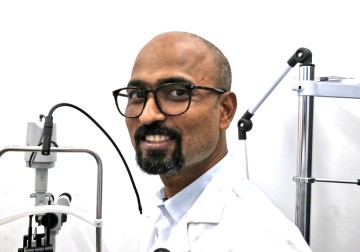Vision impairment (VI) among children can be a source of distress for them and their parents. Children find it hard to know that they have VI—a vision test can help identify it. If left untreated, loss of visual acuity can hamper academic performance, intellectual development, and the career prospects of a child.
Winston Prakash, a research optometrist at LVPEI, discusses his latest research paper that reports on the prevalence of VI and its causes among schoolchildren in the Indian state of Telangana. The study provides updated data on the visual health of children in the state.
What got you interested in public health research?
In 2004–05, as a student of optometry, I was part of a group called Operation Community Care. We would travel to Tamil Nadu’s villages to conduct community eye exams and raise awareness of ocular health issues. This effort sparked my interest in public health research. I felt that working in this field was an effective way to help people at the grassroots and make a wide-scale impact. But providing eye care is not enough; it is crucial to understand the current scenario of a disease. Years later—around 2019–2020—when I was doing my master’s at the London School of Hygiene and Tropical Medicine, I developed an interest in the epidemiology of pediatric eye diseases. This was because I found a dearth of research on childhood blindness. That lacuna in knowledge needs to be filled.
Why is it important that we screen the population for VI, especially in children?
Unlike adults, a child cannot comprehend the gravity of deteriorating vision, let alone communicate the problem. They cannot reach out to a doctor directly, so their parents are the first point of contact, who may not understand the situation well enough to pay attention. So, a lot of childhood vision problems, especially in rural areas, go unnoticed. That is why deliberate population-level screening is required to safeguard their sight.
Tell us more about the I-SCREEN project. What are its goals and what approaches are being adopted in the project to realize those goals?
I-SCREEN is a large-scale pediatric eye health program focused on schools in Andhra Pradesh and Telangana. This includes not only regular schools but also kindergarten, Anganwadi, schools for the blind, and for other disabled children. We have covered over 250 schools in Telangana alone. The goal is to provide eye care to the maximum number of children in these two states, and the best way to reach such numbers is in schools. Once our team is at a school, we screen the children for visual impairment. Children with refractive errors get treated with corrective spectacles, while complex cases get referred to various secondary and tertiary centers of LVPEI.
The study found a higher risk of VI among older children (6–15 years) compared to younger kids (4–5 years). What factors influence such variation?
The risk of VI increases with age and refractive errors are the primary cause in over 80% of children. The current evidence suggests that changes in lifestyle choices, increased use of digital gadgets, reduced outdoor exposure and excess near-work are the main reasons for this.
VI prevalence among Hyderabad’s schoolchildren is nearly twice the average of schoolchildren from three rural districts in Telangana. What factors influence this difference?
Children in urban areas spend a lot of time looking at a smartphone or tablet. COVID lockdowns only worsened the situation with online classes. Indian cities lack enough open spaces for outdoor recreation. Small smartphone screens, together with limited outdoor exposure, lead to an increased prevalence of myopia and subsequent VI among urban children.
A study from 2009 found the prevalence of VI in Hyderabad’s schoolchildren to be 7.1%, compared to your 2.24%. What could be causing such a big difference?
Differences in methodology are a reason. Previously, WHO defined VI as visual acuity less than 6/18, which has now been changed to 6/12. Variations in such parameters will result in differences in sampling and calculated prevalence. More than that, access to eye care and eye health awareness in Telangana have improved since the last decade. That could be a big reason the prevalence of VI is much lower now than in 2009.
How does a physical or mental disability increase the risk of VI among children?
The higher risk of VI is often associated with developmental issues in children with intellectual or hearing disabilities. Healthy vision depends on proper brain development. Defects in brain development can cause improper eye growth or delayed visual maturation. Moreover, mental disabilities can cause brain hypoxia, which can damage the visual cortex or lead to optic nerve atrophy. Such developmental defects or anatomical abnormalities can directly lead to VI.
How can the findings of this study be used to improve VI among children in Telangana?
Our study has shown that refractive errors are the leading cause of VI in children across Telangana. As such, interventions for refractive errors, like corrective spectacles, need to be implemented on a large scale. Our study has also shown that an efficient way to reach many children is school vision screening programs. So, the government should step in with a policy of annual eye screening in every school, carried out by government-funded vision technicians.
How can schools and parents help manage kids with VI in a better way?
Schools should be proactive in organizing vision screenings by inviting hospitals to conduct them. They should have a dedicated “vision screening day” in their annual calendar, and parents should ensure that their children participate. Finally, when a child is admitted to a school, parents and the school authority should have the child’s vision screened. That way, they would be aware of any vision problems at an early stage and could follow up on the child every year during the annual screening day.
Winston D. Prakash spoke to Sayantan Mitra, Science Writer, LVPEI. Read more about his research here.
Citation
Prakash WD, Marmamula S, Mettla AL, Keeffe J, Khanna RC. Variations in the prevalence of vision impairment across regions among school children in Telangana State, South India. Indian J Ophthalmol. 2023 Oct;71(10):3322-3327



